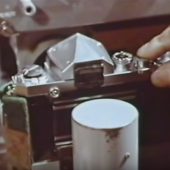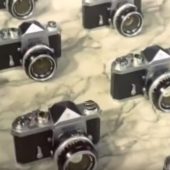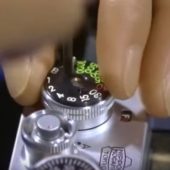


Slow news day. Enjoy these two old Nikon documentaries (both in Japanese). The first one is “Science of the eye – Nikon” from 1966:
The second documentary is “Legend of the Nikon F – portrait of every camera“:
Mr. Akira’s translation transcript (nikongear.com):
(0:45-)
Nikon F was developed in 1959, right in the middle of Japan’s high economic growth period, in this factory in Ohi, Shinagawa-ku, Tokyo.
(1:05-)
Unlike today’s fully automated production line, most of the production processes depended on the sensitive hand works of the employees.
(1:17-)
The mechanisms of automatic aperture driving system, quick return mirror, titanium foil focal plane shutter, interchangeable viewfinders of 100% field of view…Nikon F, though it was the first Nikon SLR ever, satisfied all these requirements for an SLR. Thus many pro photogs are still using the F bodies for their jobs. The footage of the factory looks really outdated, but the cameras themselves are still alive.
(1:49-)
The initial retail price of Nikon F was 67,000 JPY. At that time, the initial salary of a university degree government worker of a higher rank was 10,200 JPY. Thus the camera was not immediately affordable, but many people were fascinated by its functionality and bite the bullet to buy one.
(2:10-)
Another reason for the popularity of Nikon F was its rich accessory system. Right after the camera had hit the market, the system offered many interchangeable lenses. Nikon even offered the dedicated motor drive a year after the camera had been released.
What made Nikon develop the SLR, when it was not the mainstream of the camera industry?
(2:36-)
Before F was born, Nikon had already had SP, the pinnacle of the world of rangefinder cameras. In fact, the basic construction of F was the SP cut to the left and right halves and a mirror box put between them. That means, the basic design had already been completed.
(3:00-)
The toughness of Nikon F is a well known fact among the pro photogs. So, how durable the inner mechanism is? Here’s a comment of a technician at the maintenance company officially acknowledged by Nikon (the company is called “Kiitos”.):
“The bayonet mount of Nikon F made of stainless steel is very durable. For example, if a customer mounted a super-tele lens on an F body and hit the lens against something or dropped the combo, the mount would be rarely bent. Even if it is bent, it can be easily replaced. I’ve been repairing Nikon products for forty years, but even in that case, I’ve never seen the die-cast base of the mount had been damaged, so far as I remember.”
(3:44-)
A mirror can be seen through the mount. The housing in which the mirror swings is called the “mirror box”, the heart of an SLR.
”The only case I had to replace the mirror box was when the user had dropped the camera into the water and the metal parts had been corroded. Otherwise, I’ve never really been in need of replacing it. The only maintenance I would need is just to lube the mechanism, which will bring it back to the normally operating condition, thanks to the fact that the mirror box is made solidly and sturdily.”
(4:23-)
The durability of the shutter mechanism is tested by the actuation of nearly 150 thousand times, which can be seen in the footage shot when F was in production. The absolute durability of F had already been proved 50 years ago.
(4:43-)
The F mount whose history had begun with the release of Nikon F is now affectionately called the “eternal F mount”. A lens that is attached to F can also be attached to D3, the latest Nikon DSLR body (Ai modification required).
(5:02-)
Now, at the Ohi factory where Nikon F was developed, we interviewed Mr. Tetsuro Goto who had been involved with the development of Nikon bodies from F3 to D3.
“The reliability and the introduction of the latest technology available have always been the motto since the F era up to now with D3.”
The Space Cameras are required to function in the vacuum space where the temperature drastically swings between minus tens of degrees to plus hundreds of degrees. They are modified F and its following models and continue to take pictures that will be regarded as important records for us human beings. What kind of modifications were applied to these cameras to function under extremely severe conditions?
“FIrst of all, the usable materials are limited. The nomal machine oils will vapor immediately in the space, so we use the special lubricant recommended by NASA. Also, all of the outer parts have to be made of metal. When the base models of these Space Cameras were current, all the plastic, acrylic or rubber parts would vapor in the space. So, the rubber grips and these small plastic parts from the normal models were all replaced by the metal ones. Thus there are no plastic or rubber parts on the camera. Everything is made of NASA approved metals.”
(listen to the BEAUTIFUL shutter sound of the “Small Camera” based on F FTN in various shutter speeds!)
(7:25-)
It should be safe to say that Nikon F is a legendary camera that greatly changed the history of Japanese, no, the world’s SLR. In 2009, we celebrate the 50th anniversary of the birth of Nikon F. It surely will remain legend in many years to come.







